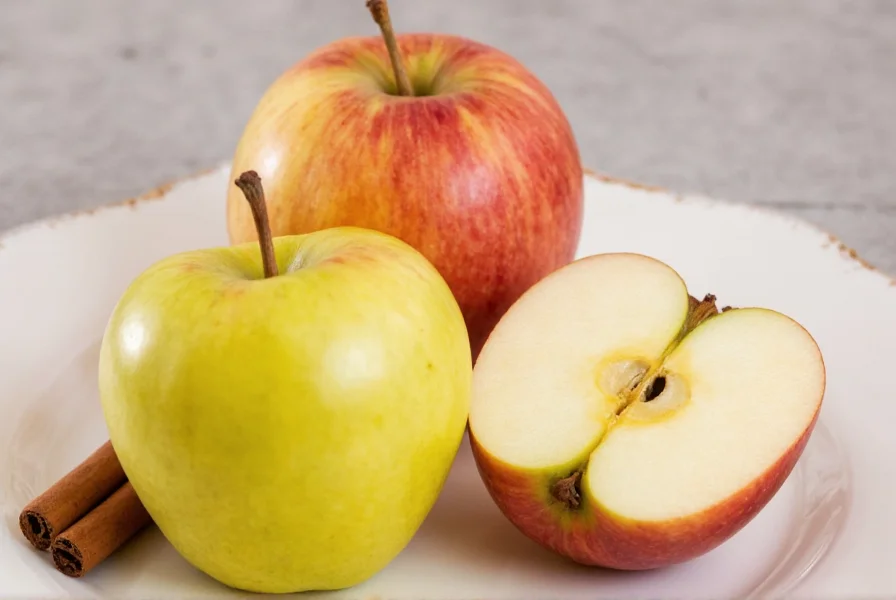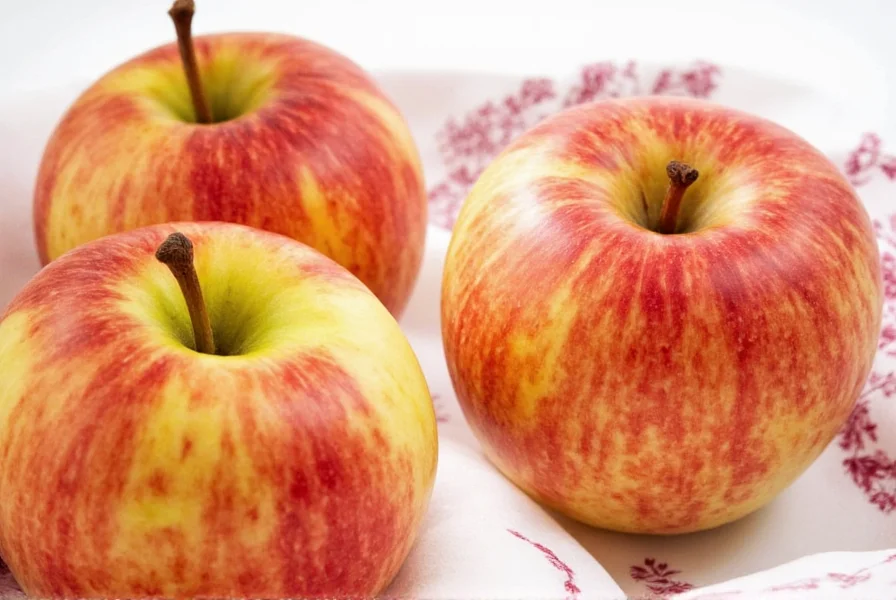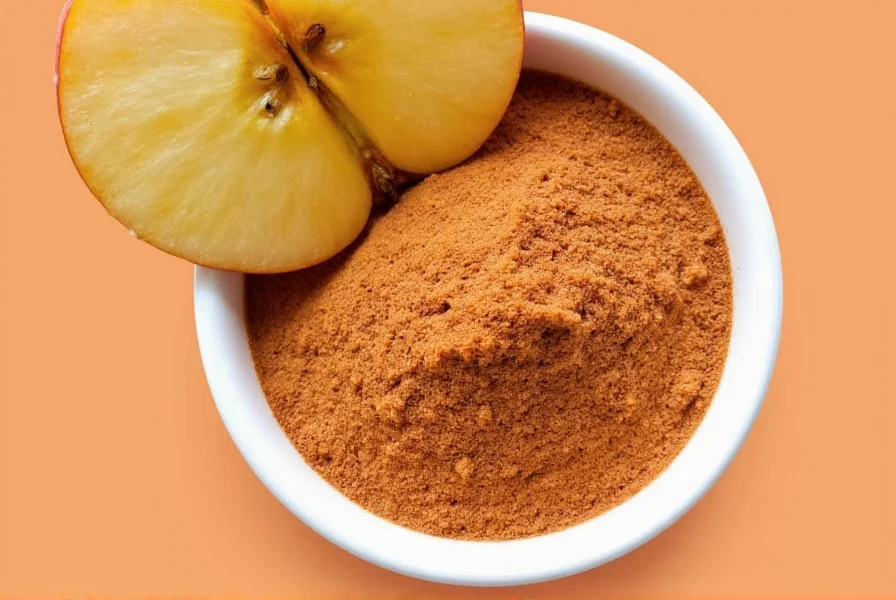For centuries, the combination of cinnamon and apple has delighted palates across cultures. This pairing isn't merely tradition—it's science. The volatile compounds in cinnamon, particularly cinnamaldehyde, interact with the esters and aldehydes naturally present in apples to create a flavor synergy that neither ingredient achieves alone. When combined, they produce a more complex aromatic profile that satisfies multiple taste receptors simultaneously.
The Science Behind the Perfect Pairing
Understanding why cinnamon and apple work so well together requires examining their chemical composition. Apples contain various esters that produce fruity notes, while cinnamon's primary compound, cinnamaldehyde, delivers that characteristic warm, spicy aroma. When these compounds interact:
| Compound | Found In | Sensory Effect | Interaction Result |
|---|---|---|---|
| Cinnamaldehyde | Cinnamon | Warm, spicy aroma | Enhances apple's natural sweetness |
| Hexyl acetate | Apples | Fruity, floral notes | Softens cinnamon's intensity |
| Eugenol | Cinnamon | Clove-like warmth | Complements apple's tartness |
| 2-hexenal | Apples | Grassy, fresh notes | Creates balanced complexity |
This chemical interaction explains why the pairing works across various apple varieties. Sweeter apples like Fuji or Gala require less added sugar when paired with cinnamon, while tart varieties like Granny Smith benefit from cinnamon's ability to mellow their sharpness without masking their distinctive flavor.
Nutritional Synergy of Cinnamon and Apple
Beyond flavor, this combination offers notable health benefits that work synergistically. Apples provide soluble fiber (pectin) and vitamin C, while cinnamon contributes polyphenol antioxidants. When consumed together:
- Blood sugar regulation: The fiber in apples slows sugar absorption, while cinnamon's compounds improve insulin sensitivity
- Antioxidant boost: The combined polyphenols create a more robust antioxidant effect than either ingredient alone
- Digestive benefits: Apple pectin and cinnamon's anti-inflammatory properties support gut health
Research published in the Journal of Agricultural and Food Chemistry confirms that certain polyphenols in apples and cinnamon work together to increase antioxidant capacity by up to 20% compared to consuming them separately—a phenomenon known as the "matrix effect."

Traditional Applications Across Cultures
The cinnamon-apple pairing appears in culinary traditions worldwide, each with distinctive preparation methods:
- European traditions: German Apfelstrudel, French Tarte Tatin, and British apple pie all feature cinnamon as the primary spice
- Middle Eastern cuisine: Stewed apples with cinnamon appear in Persian and Turkish dishes, often paired with nuts
- American adaptations: From colonial-era apple butter to modern apple cinnamon muffins, this combination remains central to North American baking
Historical records show that European settlers in North America adopted this pairing from indigenous practices—Native Americans had long used local cinnamon analogs (like sassafras) with wild apples before European contact.
Practical Applications in Modern Cooking
Understanding how to properly incorporate cinnamon and apple requires attention to timing, ratios, and preparation methods. Here's what experienced chefs recommend:
Optimal Ratios for Different Applications
The perfect cinnamon-to-apple ratio varies significantly based on your application:
- Baking (pies, crisps): 1-2 teaspoons ground cinnamon per 3 cups of sliced apples
- Stovetop preparations (sauces, compotes): 1/2-1 teaspoon per 2 cups of apples
- Savory applications (roasted meats with apple): 1/4-1/2 teaspoon per 2 cups of apples
- Beverages (ciders, teas): 1 cinnamon stick per 4 cups of liquid with apple
For best results, add ground cinnamon early in baking to allow flavors to meld, but add it later in stovetop preparations to preserve its volatile compounds. When using cinnamon sticks, simmer them with apples for at least 15 minutes to extract maximum flavor.
Choosing the Right Cinnamon Variety
Not all cinnamon works equally well with apples. Understanding the differences can elevate your dishes:
- Ceylon cinnamon: Delicate, citrusy notes work best with sweeter apple varieties in refined desserts
- Cassia cinnamon: Stronger, more intense flavor complements tart apples in pies and crisps
- Indonesian cinnamon: Earthier profile suits savory applications with apples
For most traditional apple recipes, Cassia cinnamon provides the familiar warm spice profile people expect, while Ceylon offers a more nuanced alternative for sophisticated preparations.

Avoiding Common Preparation Mistakes
Even experienced cooks sometimes miss these critical details when working with cinnamon and apple:
- Adding cinnamon too late in baking: Ground cinnamon needs time to hydrate and release its flavor compounds
- Using pre-sugared cinnamon: This limits your control over sweetness and can create uneven distribution
- Not adjusting for apple variety: Sweeter apples need less added sugar when paired with cinnamon
- Overpowering with cinnamon: The spice should complement, not dominate, the apple flavor
Professional bakers recommend blooming ground cinnamon in a small amount of warm liquid (like apple juice or melted butter) before incorporating it into apple mixtures. This technique maximizes flavor extraction and ensures even distribution.
Three Versatile Cinnamon-Apple Preparations
Here are three approaches to this classic pairing that work for different skill levels and occasions:
Simple Stovetop Cinnamon Apples (15 minutes)
Peel and slice 3 medium apples. Melt 1 tablespoon butter in a skillet over medium heat. Add apples, 1 teaspoon cinnamon, 1 tablespoon lemon juice, and 2 tablespoons water. Cook 10-12 minutes until tender but not mushy. Perfect for topping oatmeal or yogurt.
Classic Apple Cinnamon Muffins (Intermediate)
Combine 2 cups flour, 1 cup sugar, 2 teaspoons cinnamon, 2 teaspoons baking powder, and 1/2 teaspoon salt. In another bowl, mix 2 eggs, 1/2 cup oil, 1/2 cup milk, and 1 teaspoon vanilla. Fold wet into dry ingredients, then gently fold in 1.5 cups diced apples. Fill muffin cups 3/4 full and bake at 375°F for 18-20 minutes.
Deconstructed Apple Cinnamon Galette (Advanced)
Prepare a simple pie dough. Roll into a rustic circle. Toss 3 cups thinly sliced apples with 1/4 cup sugar, 1.5 teaspoons cinnamon, 1 tablespoon flour, and 1 tablespoon lemon juice. Pile apples in center of dough, leaving 2-inch border. Fold edges over filling. Brush crust with egg wash, sprinkle with coarse sugar. Bake at 375°F for 35-40 minutes until golden.
Storage and Shelf Life Considerations
Proper storage maintains the quality of cinnamon-apple preparations:
- Raw apple slices with cinnamon: Consume within 24 hours for best quality
- Cooked cinnamon apples: Refrigerate for up to 5 days
- Baked goods: Store in airtight container for 2-3 days at room temperature
- Freezing: Baked goods freeze well for up to 3 months; cooked apples for 2 months
When freezing cinnamon-apple preparations, add a squeeze of lemon juice to prevent browning and maintain flavor integrity. Thaw frozen items in the refrigerator overnight before reheating.
Conclusion: The Enduring Appeal of Cinnamon and Apple
The cinnamon-apple pairing endures because it satisfies multiple sensory dimensions while offering practical culinary flexibility. Whether you're preparing a quick weeknight dessert or an elaborate holiday centerpiece, understanding the science and tradition behind this combination allows you to create more intentional, flavorful results. By respecting the optimal ratios, preparation techniques, and complementary properties of these ingredients, you can elevate simple ingredients into memorable culinary experiences that connect us to centuries of shared food heritage.
Frequently Asked Questions
What's the best cinnamon variety for apple pie?
Cassia cinnamon provides the familiar warm, intense flavor most associated with traditional apple pie. Its stronger profile stands up well to baking and complements tart apple varieties like Granny Smith. For a more nuanced alternative, try blending equal parts Cassia and Ceylon cinnamon.
How can I prevent my cinnamon apples from becoming mushy?
Choose firmer apple varieties like Honeycrisp or Braeburn, slice them uniformly (about 1/4-inch thick), and add them to the cooking process at the right time. For stovetop preparations, cook just until tender-crisp. In baking, toss apple slices with a tablespoon of flour or cornstarch to absorb excess moisture during cooking.
Can I use cinnamon sticks instead of ground cinnamon with apples?
Yes, cinnamon sticks work beautifully with apples, particularly in liquid-based preparations like ciders or compotes. Use one standard cinnamon stick per 2-3 cups of apples and simmer for at least 15 minutes to extract maximum flavor. Remove the stick before serving as it doesn't fully dissolve.
Do cinnamon and apple have complementary health benefits?
Research shows cinnamon and apple create a synergistic effect. Apples provide soluble fiber (pectin) that slows sugar absorption, while cinnamon contains compounds that improve insulin sensitivity. Together, they create a more balanced blood sugar response than either ingredient alone, making this combination particularly beneficial for metabolic health.
Why does cinnamon sometimes overpower apple flavor?
Cinnamon contains potent volatile compounds that can dominate more delicate apple flavors if used excessively. This happens most often with sweet apple varieties that have subtler flavor profiles. To prevent this, start with smaller amounts (1/2 teaspoon per 3 cups of apples) and adjust to taste, remembering that cinnamon's flavor intensifies during cooking.











 浙公网安备
33010002000092号
浙公网安备
33010002000092号 浙B2-20120091-4
浙B2-20120091-4